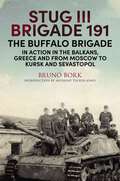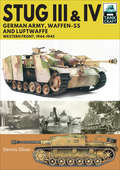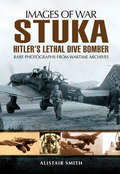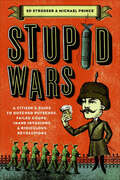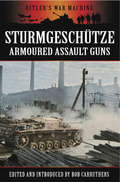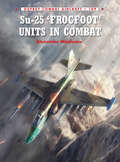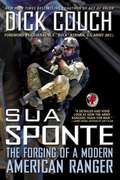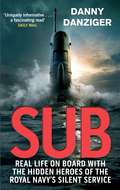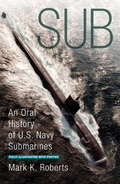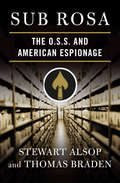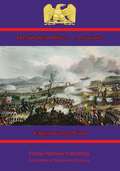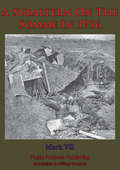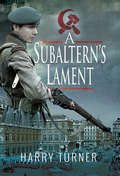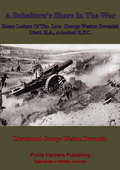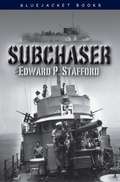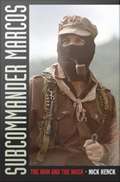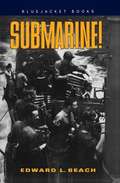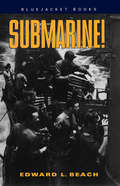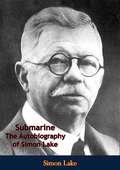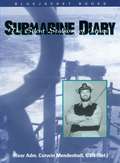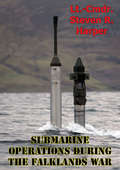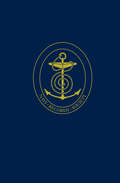- Table View
- List View
StuG III Brigade 191, 1940–1945: The Buffalo Brigade in Action in the Balkans, Greece and from Moscow to Kursk and Sevastopol
by Bruno BorkAn illustrated history of one brigade of German World War II armored fighting vehicles and the action they saw along the Eastern Front. Based on their experiences during the First World War, the Reichswehr decided that the infantry support gun of the future should be an armored, motorized vehicle with an effective caliber of cannon: the Sturmgeschütz III. The weapon was used in the &“fire brigade role&” at hotspots along the Front, where it was much feared by enemy forces. This illustrated volume tells the tale of Brigade 191, aka the &“Buffalo Brigade,&” who used the Sturmgeschütz III as they took part in Operation Barbarossa in the Ukraine, saw action during the fight for Greece in 1941 and were deployed to the areas of heaviest fighting in the campaign against the Soviet Union. This began with the infantry advance from Ukraine to Moscow (1941): then to Voronezh, Kursk, the Caucasus, and Kuban (1942), then the Kertsch Peninsula and the Crimea (1943-1944), before they were finally evacuated from Sevastopol into Romania by naval lighters. On the South-east Front (the retreat through the Balkans), the Brigade fought its way into Austria and was still fighting on the last day of the war to keep a corridor open. Keen to write an account recording the tactical significance of the Sturmgeschütz III, while surviving members of Brigade 191 also wished for a cohesive documentary record of the war, Bork set about gathering military records and literature, as well as interviewing as many ex-Brigade men as possible, in order to bring this detailed account into being.Praise for StuG III Brigade 191, 1940–1945 &“Author Bruno Bork not only offers a tactical unit history, but also another German &“blood and guts&” ground-level views of Hitler&’s retreats and defeats on the Eastern Front. This is also a truly riveting read.&” —ARGunners.com &“Upon finishing this book the reader will doubtlessly better realize what a useful and versatile armored fighting vehicle the Sturmgeschütz III really was to the German armed forces.&” —Globe at War &“As a unit history, the scenarios come a poppin on page after page.&” —Historical Miniatures Gaming Society &“Highly recommended for beginner to advanced builders and historians interested in the StuG actions on the Eastern Front.&” —AMPS
Stug III & Stug IV: German Army, Waffen-SS and Luftwaffe: Western Front, 1944–1945 (TankCraft)
by Dennis OliverA guide that blends the history behind this German World War II tank with resources for military vehicle modeling enthusiasts. In the last years of the Second World War the Sturmgeschütz III (StuG III) and Sturmgeschütz IV (StuG IV) played a vital role as assault guns during the German army&’s struggle to block the Allied advance on the Western Front. As the Wehrmacht&’s tank forces declined, these armored vehicles were thrown into every defensive operation. They are not as well-known as the Tigers and Panthers, but German resistance would have been much weaker without them. They were also among the most frequently encountered German armored vehicles on the battlefields, which is why they are such a fascinating subject for Dennis Oliver in this volume in the TankCraft series He uses archive photos and extensively researched color illustrations to examine the StuG III and StuG IV deployed by the German army and the Waffen-SS during these doomed campaigns. A key section of his book displays available model kits and aftermarket products, complemented by a gallery of beautifully constructed and painted models in various scales. Technical details as well as modifications introduced during production and in the field are also examined providing everything the modeler needs to recreate an accurate representation of these historic armored vehicles.
Stuka: Hitler's Lethal Dive Bomber (Images Of War Bks.)
by Alistair SmithThe photographs in this collection belonged to Luftwaffe Stuka rear gunner and radio operator Erich Heine. The collection includes photographs of flights of Stukas in formation, operating training aircraft, and a selection of different Luftwaffe uniforms and flight gear. The photographer was based for a period in Czechoslovakia, was shot down over the Ukraine in August 1943 and for a time was listed as missing in action.
Stupid Wars: A Citizen's Guide to Botched Putsches, Failed Coups, Inane Invasions & Ridiculous Revolutions
by Ed Strosser Michael PrinceWhen winners write history, they sometimes "forget" to include their own embarrassing misjudgments. Fortunately, this take-no-prisoners edition of history isn't going to let the winners (or the losers) forget the mistakes of the past. Be prepared to laugh out loud—and gasp in horror—at the most painfully idiotic strategies, alliances, and decisions the world has ever known. These stupid wars have been launched by democracies as well as monarchies and dictatorships, in recent decades just as often as in less "enlightened" times. The ridiculous and reckless conflicts chronicled in Stupid Wars include the misdirected Fourth Crusade, the half-baked invasion of Russia by the U.S., the U.K.'s baffling Falklands War, Hitler's ill-fated Beer Hall Putsch, several incredibly foolish South American conflicts, the Bay of Pigs fiasco, and many more. Whether you're a future dictator, war-mongering politician, royal mistress, or history lover, these blow-by-stupid-blow accounts will teach you the valuable lessons you need to stay off the list, including: Don't declare war on all your neighbors at the same time.Working radios, accurate maps, and weather-appropriate uniforms are big plusses.Large amounts of bird poop and very small islands are probably not worth dying for.Never invade Russia. Seriously. It's a really bad idea.
Sturmgeschütze: Armoured Assault Guns (Hitler's War Machine)
by Bob CarruthersAn overview of the Wehrmacht&’s little-known mobile assault guns designed to provide close infantry support against enemy field defenses in World War II. The Stürmgeschutze rumbling forward into action is one of the iconic images of World War II. As mobile assault guns, the StuGs were essentially designed as infantry support weapons, but they also proved themselves as highly effective tank destroyers. Written by Emmy Award-winning author Bob Carruthers this fascinating study encompasses the design, development and combat history of the StuG II and IV. Drawing on a variety of rare primary sources and photographs this outstanding study explains the role of the StuG in context and examines the combat records of the StuG aces such as Franz von Malachowski, and Knight&’s Cross holder Oberwachtmeister Hugo Primozic of Stug.Abt.667. Indispensable reading for anyone with an interest in armored warfare, this book is part of the Hitler&’s War Machine series, a new military history range compiled and edited by Emmy Award winning-author and historian Bob Carruthers. The series draws on primary sources and contemporary documents to provide a new insight into the true nature of Hitler&’s Wehrmacht.
Su-25 'Frogfoot' Units In Combat
by Alexander Miladenov Rolando UgoliniUncover the technical features and operational performance of the Soviet Su-25 'Frogfoot', which proved itself as a durable and versatile attack aircraft in a variety of theaters in the middle East. Had the Cold War developed into a more serious conflict, the Su-25 would have been the main Soviet combat type facing US aircraft.Today it is widely accepted as the true successor to the types of specialized ground--attack aircraft that emerged during World War II. The book details the service history of the 'Frogfoot' during more than 30 years of combat using first-hand accounts and revealing archive photographs. The Su-25 has often been underrated, but the faithful 'Frogfoot' is now slated to remain in service with most of its current operators across the globe until at least 2020. This study explores the successes of the Su-25 in full, demonstrating its' strengths as a formidably armed, armored and very agile attack aircraft.
Sua Sponte
by Dick CouchSua Sponte Latin for "Of Their Own Accord" The 75th Ranger Regiment's Motto Army Rangers are not born. They are made. The modern 75th Ranger Regiment represents the culmination of 250 years of American soldiering. As a fighting force with our nation's oldest and deepest tradition, the Regiment traces its origins to Richard Rogers's Rangers during the prerevolutionary French and Indian War, through the likes of Francis Marion and John Mosby, to the five active Ranger battalions of the Second World War, and finally, to the four battalions of the current Ranger regiment engaged in modern combat. Granted unprecedented access to the training of this highly restricted component of America's Special Operations Forces in a time of war, retired Navy captain Dick Couch tells the personal story of the young men who begin this difficult and dangerous journey to become Rangers. Many will try, but only a select few will survive to serve in the 75th Ranger Regiment. Sua Sponte follows a group of these aspiring young warriors through the crucible that is Ranger training and their preparation for direct-action missions in Afghanistan against America's enemies, anywhere, any time, and under any conditions. INCLUDES PHOTOGRAPHS
Sub: Real Life on Board with the Hidden Heroes of the Royal Navy's Silent Service
by Danny Danziger300 million cubic miles of ocean.Stealthy, and deadly, the nuclear submarines of the Royal Navy lie in wait in the depths of the world's oceans, ready to listen, intercept, and attack wherever they may be needed - from the coastline of Libya to the ice caps of the Arctic. If the UK is hit by a devastating nuclear strike, they'll be the last military force standing.200 million pounds of hardware.Award-winning journalist Danny Danziger has been allowed unprecedented access to the elite crew of one of the UK's attack class submarines, joining them on operations and hearing their stories. Unrestricted, and uncompromising, Sub paints a vivid picture of this fascinating, little-known branch of our armed forces.One incredible hunter-killer.In an increasingly unstable world, these are the people who keep us safe. It is time for the silent service to be heard.
Sub: Real Life on Board with the Hidden Heroes of the Royal Navy's Silent Service
by Danny Danziger300 million cubic miles of ocean.Stealthy, and deadly, the nuclear submarines of the Royal Navy lie in wait in the depths of the world's oceans, ready to listen, intercept, and attack wherever they may be needed - from the coastline of Libya to the ice caps of the Arctic. If the UK is hit by a devastating nuclear strike, they'll be the last military force standing.200 million pounds of hardware.Award-winning journalist Danny Danziger has been allowed unprecedented access to the elite crew of one of the UK's attack class submarines, joining them on operations and hearing their stories. Unrestricted, and uncompromising, Sub paints a vivid picture of this fascinating, little-known branch of our armed forces.One incredible hunter-killer.In an increasingly unstable world, these are the people who keep us safe. It is time for the silent service to be heard.
Sub
by Mark RobertsTrue tales of life and death as told by those who fought in the briny depths. From the undersea warfare of World War II through the Cold War stand-offs in the deep to the cutting-edge technology of the modern U.S. Navy, submarines have evolved into the front line of our nation's defense at sea. And the men who sail them have become heroes above and below the waves. These are their stories. Compiled from interviews and recollections from submarine veterans and accompanied by detailed photos and illustrations of both man and machine at work, Sub is a gripping chronicle of undersea warfare as told by those who know firsthand what it means to drop through the hull of a boat, to sink into the dark, freezing waters of the deep-and to have death never more than one torpedo away.
Sub Rosa: The O. S. S. and American Espionage
by Stewart Alsop Thomas BradenA thrilling history of the Office of Strategic Services, America's precursor to the CIA, and its secret operations behind enemy lines during World War II. Born in the fires of the Second World War, the Office of Strategic Services, or OSS, was the brainchild of legendary US Maj. Gen. William "Wild Bill" Donovan, designed to provide covert aid to resistance fighters in European nations occupied by Germany's Nazi aggressors. Paratroopers Stewart Alsop and Thomas Braden--both of whom would become important political columnists in postwar years--became part of Wild Bill's able collection of soldiers, spies, and covert operatives. Sub Rosa is an enthralling insider's history of the remarkable intelligence operation that gave birth to the CIA. In Sub Rosa, Alsop and Braden take readers on a breathtaking journey through the birth and development of the top secret wartime espionage organization and detail many of the extraordinary OSS missions in France, Germany, Dakar and Casablanca in North Africa, and in the jungles of Burma that helped to hasten the end of the Japanese Empire and the fall of Adolf Hitler's powerful Reich. As exciting as any international thriller written by Eric Ambler or Graham Greene, Alsop and Braden's Sub Rosa is an indispensable addition to the literary history of American espionage and intelligence.
The Subaltern
by George Robert Gleig Pickle Partners PublishingThis ebook is purpose built and is proof-read and re-type set from the original to provide an outstanding experience of reflowing text for an ebook reader. The Reverend Gleig was a famous military author of his day, a former officer in the British army, a commentator on military matters and a close relationship with the Iron Duke, Wellington. He wrote many works and articles including a biography of Wellington, a book based on his own experiences during the war of 1812 in America and editing the memoirs of a Chelsea pensioner. Originally published as a series of articles in Blackwoods Magazine, in the 1820s Reverend Gleig's most famous novel, The Subaltern, was published as a book in its own right soon after going through numerous editions. It presents a slightly coloured and retouched memoir of Gleig's own experiences in the Duke's army in the Peninsular and the invasion of the South of France. Somewhat lighter in tone than some of the more gruesome memoirs written of the war, it is a fascinating read. Text taken, whole and complete, from the 1825 edition, published in Edinburgh by William Blackwood. Original - 392 pages. Author- George Robert Gleig 1796-1888 (1844-1912) Linked TOC.
The Subaltern Officer. — A Narrative
by Captain George WoodThis ebook is purpose built and is proof-read and re-type set from the original to provide an outstanding experience of reflowing text for an ebook reader. George Foot started his military career in the Peninsula as a Lieutenant in the 82nd Foot, Prince of Wales's Volunteers, having being involved in the initial struggles around Lisbon at Roliça and Vimiero in 1808, before the general action at Talavera in 1809. Interestingly, he transferred to the 2nd Battalion of Detachments for the rest of the War before being seriously wounded at the battle of the Pyrenees. His narrative is enlivened with an eye for detail both in the battles he fought in and the towns and villages that he and his foot-sore comrades tramped through. Title - The Subaltern Officer. -- A Narrative Author -- Captain George Wood Text taken, whole and complete, from the edition published in 1825, London, by Septimus Prowett Original - xvi and 247 pages. Illustrations -- one illustrations.
A Subaltern On The Somme In 1916
by Mark Vii Pseud."The author of this memoir arrived on the Western Front to join 10th Bn. West Yorks in July 1916, shortly after the opening day of the Battle of the Somme in which his battalion had suffered the highest casualties of any battalion on that day - 710 of whom 306 were killed. His war ended in January 1917 when he was concussed by a shell exploding on the parapet in front of him.Regarded as one of the classics the book gives a vivid description of life in the trenches - the routine, the boredom , the mud and the horror. His war ended in January 1917 when he was concussed by a shell exploding on the parapet in front of him. Well recommended."-N&M Print Version
A Subaltern's Lament
by Harry TurnerVienna 1954, nine years after the end of World War II and the victorious allies occupy the whole of Austria.Newly commissioned national serviceman and Fulham boy, Rory Trenchard, joins his regiment, The Hambleshires, in Vienna at the very height of the Cold War. At nineteen he finds himself not only learning the tough art of soldiering alongside his platoon of Battle hardened Korean War veterans but is also exposed to the political machinations that exist between Britain and her Allies.Vienna in 1954 is a dangerous place and in addition to honing his skills as a warrior he is trusted to act as a go-between when a senior KGB officer plans to defect to the west. He also falls in and out of love with an American girl and faces the choice of either just completing two years national service, or becoming a regular officer.
A Subaltern’s Share In The War: Home Letters Of The Late George Weston Devenish Lieut. R.A., Attached R.F.C.
by Lieutenant George Weston DevenishLieutenant Devenish celebrated his twenty-first birthday, his last in peace-time, on the 25th of July 1914; he was by this point in his short life a soldier by profession and by choice. Having left Charterhouse with a taste for military ways after training in the O.T.C., he decided that his chosen profession should be spent in the Royal Artillery and entered into further training at Woolwich. By the time war begun in 1914 he was a fully-fledged officer. However, an indomitable spirit and a thirst for a more personal form of combat led him into the Royal Flying Corps. The R.F.C. would mourn his passing on the 6th of June 1917, after only a year of having him in their ranks. George Devenish's name is inscribed on the walls of the Arras Flying Services War Memorial, one of the many Allied fliers who lost their lives during the First World War fighting in the skies above the Western Front. A kindly, sensitive man, but filled with a great deal of passion and pride, his letters are almost always upbeat and despite the carnage around him during the war, he never changed his "sunny disposition".Author -- Lieutenant George Weston Devenish 1893-1917Text taken, whole and complete, from the edition published in London, Constable and Company Ltd., 1917.Original Page Count - xviii and 177 pages.
Subchaser
by Edward P. StaffordIn a wartime Navy of giant carriers and battleships, tiny wooden subchasers did not command much attention. Yet these 110-foot warships, manned mostly by inexperienced reservists, performed vital chores for the fleet everywhere there was action in World War II. They led landing craft right up to the assault beaches, protected them from fire, fought off air attacks, swept for mines, laid down smoke screens, and patrolled the sea for killer submarines. One such doughty little ship, subchaser 692, is the subject of this book.Told by 692's commanding officer Ed Stafford, then a twenty-four-year-old lieutenant (jg) on his first warship, the story follows the thirty-man crew as they scrapped their way through the war, including action during the July 1943 invasion of Sicily. Filled with humor, tension, poignancy, and moments of high drama, this volume leaves today's readers with a vivid image of life on a very small ship in a very big war.
Subcommander Marcos: The Man and the Mask
by Nick HenckSubcommander Marcos made his debut on the world stage on January 1, 1994, the day the North American Free Trade Agreement took effect. At dawn, from a town-hall balcony he announced that the Zapatista Army of National Liberation had seized several towns in the Mexican state of Chiapas in rebellion against the government; by sunset Marcos was on his way to becoming the most famous guerrilla leader since Che Guevara. Subsequently, through a succession of interviews, communiqus, and public spectacles, the Subcommander emerged as a charismatic spokesperson for the indigenous Zapatista uprising and a rallying figure in the international anti-globalization movement. In this, the first English-language biography of Subcommander Marcos, Nick Henck describes the thought, leadership, and personality of this charismatic rebel spokesperson. He traces Marcos's development from his provincial middle-class upbringing, through his academic career and immersion in the clandestine world of armed guerrillas, to his emergence as the iconic Subcommander. Henck reflects on what motivated an urbane university professor to reject a life of comfort in Mexico City in favor of one of hardship as a guerrilla in the mountainous jungles of Chiapas, and he examines how Marcos became a conduit through which impoverished indigenous Mexicans could communicate with the world. Henck fully explores both the rebel leader's renowned media savvy and his equally important flexibility of mind. He shows how Marcos's speeches and extensive writings demonstrate not only the Subcommander's erudition but also his rejection of Marxist dogmatism. Finally, Henck contextualizes Marcos, locating him firmly within the Latin American guerrilla tradition.
Submarine
by Edward L. Beach"Welcomed as the first book about American submarines in World War II to be written by a man who actually fought in them, this account of the war beneath the sea firmly established Edward L. Beach's reputation as a writer in the early 1950s. Given the survival rate of those in the silent service, it is a story many submariners did not live to tell. In fact, most of the crew of Beach's boat, the USS Trigger, were lost soon after he left for another assignment. A veteran of twelve war patrols, Beach authentically recaptures the moments of elation, desperation, and numbing fear that were part of the daily lives of these warriors as they hunted down the enemy in the Pacific." "Beach helped sink the Trigger's first ships and survived more than his share of exploding depth charges from avenging warships. This book weaves the Trigger's story with the equally thrilling tales of other battle-hardened submarines and the brave men who fought in them against the Japanese. Readers share in the destruction of five destroyers in four days and join in the deadliest game of all - stalking other submarines. They also come to understand the terror and uncertainty of being at the other end of the pursuit, and silently sweating out depth-charge poundings in a leaking boat. For an authentic account of what went on under the waves, this book remains one of the very best."--BOOK JACKET. Title Summary field provided by Blackwell North America, Inc. All Rights Reserved
Submarine!
by Edward L. BeachFor the World War II submariner, every day was a life-or-death trial: going to sea for months at a time; existing in dank, claustrophobic conditions; enduring long stretches of monotonous silence punctuated by adrenaline-spiked episodes of paralyzing fear and victorious elation. It was a duty few men could handle -- and even fewer would survive.This is the true story of those brave men who served and too often died under the ocean surface, written by a man who was there. Edward L. Beach masterfully weaves his gripping experiences aboard the USS Trigger with those of other boats fighting the war in the Pacific. Part action-packed combat chronicle, part testament to the courageous sacrifices made by those who never came back, this is a compelling eyewitness account of the war as few have seen it.
Submarine: The Autobiography of Simon Lake
by Simon LakePERHAPS no man in the past century has had as much to do with the shape of history as Simon Lake. That statement is intended as a query rather than as a statement of fact. It may be debatable, but it is also defendable.He is responsible for the modern submarine.The World War pivoted on him. Not on the Kaiser or Lloyd George or Hindenburg or Wilson or Ludendorff. He had nothing to do with the provocations or the settlements. He was an engineer almost unknown except on the coast of New Jersey and in a few capitals of Europe. His sympathies were not warmly engaged for either of the parties to the conflict. Not until the United States entered the war was he greatly stirred.Yet the pitch-pine boat he stitched and screwed and nailed together as a boy rattled a mighty empire. Great Britain’s crown as Queen of the Seas almost slipped off her imperial head. If she had gone down, France must have gone with her. The consequences of such a collapse are now incalculable. Today’s world may have been no worse than it is, but it must have been almost insanely different.
The Submarine: A History
by Thomas ParrishThe importance of submarines in the wars of the twentieth century.
Submarine Diary
by Corwin MendenhallA vividly detailed account of life aboard U.S. submarines in the Pacific during World War II.
Submarine Operations During The Falklands War
by Lieutenant Commander Steven R. HarperThis paper contains an analysis of submarine operations during the Falklands War. This was done to provide some insight on the importance of submarines in this conflict and to show the usefulness of submarines in any maritime conflict The submarine operations by both belligerents are looked at and compared over the duration of the conflict This is an unclassified study that was researched using published books, magazine articles, unpublished papers, unclassified government documents and interviews with officers involved in the conflict Reports done at a classified level were not used in the preparation of this paper. The submarine operations and methods of employment examined show the strength of submarines when properly used and the weakness when training is lacking or the submarine is used in the wrong manner. Also highlighted is the difficulty of antisubmarine efforts in a high ambient noise, shallow water environment Submarines can be a force multiplier to any navy when used properly and can frustrate an opponent by their presence or even their perceived presence. However, to get the full use of submarines they must be integrated fully into the military forces. With just a few boats in a navy, the submarines are wasted if they are operated independently. They must be fed intelligence or be intelligence platforms themselves to fully realize their potential. This point was not adhered to fully and thus submarines did not make the impact expected during the Falklands War.
The Submarine Service, 1900–1918 (Navy Records Society Publications #142)
by Nicholas LambertThe year 2001 marks the centenary of the Royal Navy's submarine service. In the aftermath of the 2016 celebrations of the Battle of Jutland centenary, it is worth considering how the First World War at sea changed. This volume opens with an examination of the background to the Board of Admiralty's decision in 1900 to buy submarines, bringing to light documents that go a long way toward dispelling the myth that Britain's pre-1914 naval leaders were opposed to the development of the submarine as a major weapon. Indeed, the documents show that senior naval officers and influential civilians in Whitehall believed that the advent of the submarine would revolutionize naval warfare in a way that would bolster the Royal Navy's position as the world's predominant naval power. This edited selection of documents illustrates not only the Admiralty's thinking on the employment of the submarine between 1900 and 1918, it also charts the technical development of British submarines, and explains issues such as why the pioneer submariners came to regard themselves as an élite group within the Royal Navy - and were allowed to become the 'silent service'.
